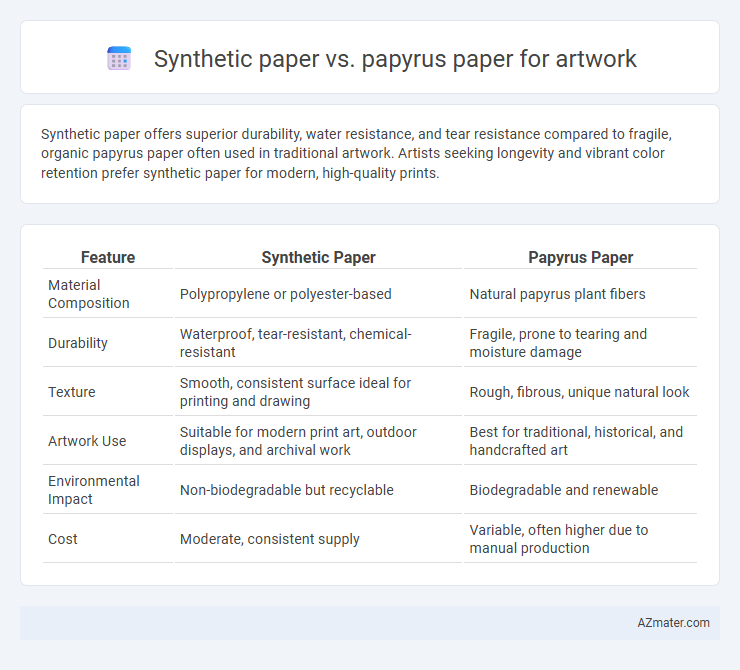Synthetic paper offers superior durability, water resistance, and tear resistance compared to fragile, organic papyrus paper often used in traditional artwork. Artists seeking longevity and vibrant color retention prefer synthetic paper for modern, high-quality prints.
Table of Comparison
| Feature | Synthetic Paper | Papyrus Paper |
|---|---|---|
| Material Composition | Polypropylene or polyester-based | Natural papyrus plant fibers |
| Durability | Waterproof, tear-resistant, chemical-resistant | Fragile, prone to tearing and moisture damage |
| Texture | Smooth, consistent surface ideal for printing and drawing | Rough, fibrous, unique natural look |
| Artwork Use | Suitable for modern print art, outdoor displays, and archival work | Best for traditional, historical, and handcrafted art |
| Environmental Impact | Non-biodegradable but recyclable | Biodegradable and renewable |
| Cost | Moderate, consistent supply | Variable, often higher due to manual production |
Introduction to Synthetic and Papyrus Paper
Synthetic paper is a durable, water-resistant material made from plastic polymers, offering smooth surfaces ideal for vibrant ink adhesion and longevity in artwork. Papyrus paper, crafted from the pith of the papyrus plant, features a textured, fibrous surface that provides a unique, historical aesthetic favored in traditional and cultural artworks. Choosing between synthetic and papyrus paper depends on desired durability, texture, and artistic effect, with synthetic paper excelling in modern prints and papyrus paper embodying ancient artistic heritage.
Historical Background of Papyrus Paper
Papyrus paper, dating back to ancient Egypt around 3000 BCE, was one of the earliest writing materials made by layering and pressing thin strips of the papyrus plant. This organic, textured medium was pivotal for documenting art, literature, and religious texts, offering a natural surface with unique grain patterns that influenced artistic expression. Synthetic paper, by contrast, is a modern invention made from plastic resins, providing durability and water resistance but lacking the historical and cultural authenticity embedded in papyrus artwork.
Modern Innovation: What is Synthetic Paper?
Synthetic paper is a modern innovation made from plastic polymers, designed to mimic the texture and durability of traditional paper while offering water resistance, tear resistance, and longevity ideal for artwork. Unlike papyrus paper, which is an ancient material derived from the pith of the papyrus plant, synthetic paper excels in providing a smooth, consistent surface that resists fading and damage from environmental exposure. This makes synthetic paper a preferred choice for contemporary artists and designers seeking durable, vibrant, and versatile media for prints, illustrations, and mixed media artworks.
Composition and Production Processes
Synthetic paper is made from plastic polymers such as polypropylene, providing a smooth, waterproof surface ideal for durability and vibrant ink absorption in artwork. Papyrus paper originates from the pith of the papyrus plant, processed by layering thin strips and pressing them together to create a textured, fibrous medium with natural organic patterns. The production of synthetic paper involves extrusion and calendaring techniques for uniformity, whereas papyrus production relies on traditional manual harvesting and pressing methods, influencing the tactile quality and historical aesthetic of the final artwork.
Texture and Surface Properties
Synthetic paper offers a smooth, consistent surface with high durability and resistance to water and tearing, making it ideal for detailed artwork and mixed media. Papyrus paper features a textured, fibrous surface with a natural, organic feel that enhances traditional and historical art styles but is more fragile and less uniform. Artists prioritize synthetic paper for longevity and precision, while papyrus is favored for its unique tactile quality and cultural authenticity.
Durability and Longevity in Art Applications
Synthetic paper offers superior durability and resistance to water, tearing, and fading compared to papyrus paper, making it ideal for long-lasting artwork. Papyrus paper, while historically significant, is more prone to brittleness and deterioration over time due to its organic materials. Artists seeking longevity in their pieces often prefer synthetic paper for its ability to maintain color vibrancy and structural integrity in various environmental conditions.
Compatibility with Art Mediums (Ink, Paint, etc.)
Synthetic paper offers superior compatibility with a wide range of art mediums such as ink, acrylic paint, and markers due to its non-porous, smooth surface that prevents bleeding and smudging. Papyrus paper, made from natural plant fibers, absorbs ink and paint more readily, which can cause feathering and uneven saturation, making it less ideal for detailed artwork requiring precision. Artists seeking durability and vibrant color retention often prefer synthetic paper for mixed-media projects, while papyrus is favored for traditional or textured effects.
Environmental Impact and Sustainability
Synthetic paper offers enhanced durability and water resistance while being recyclable, yet it is typically made from non-biodegradable plastics, raising concerns about microplastic pollution. Papyrus paper, derived from the Cyperus papyrus plant, is biodegradable and biodegradable, promoting sustainability due to its natural origin and minimal processing requirements. Choosing papyrus paper supports eco-friendly practices by reducing reliance on synthetic materials and minimizing waste in artwork production.
Cost Comparison and Accessibility
Synthetic paper offers a cost-effective alternative for artwork, with prices generally lower than traditional papyrus paper, making it accessible for artists on a budget. Papyrus paper, often imported and handcrafted, tends to be pricier and less readily available in many markets, especially outside regions like Egypt. The widespread distribution and durability of synthetic paper contribute to its greater accessibility compared to the specialized sourcing required for authentic papyrus paper.
Choosing the Right Paper for Your Artwork
Synthetic paper offers superior durability, water resistance, and a smooth surface that enhances ink vibrancy, making it ideal for detailed artwork and outdoor displays. Papyrus paper, with its textured, fibrous quality and historical significance, provides a unique aesthetic suited for traditional art and calligraphy, though it is more fragile and less resistant to moisture. Choosing the right paper depends on the artwork's purpose: synthetic paper excels in longevity and vibrant color retention, while papyrus emphasizes cultural authenticity and texture.

Infographic: Synthetic paper vs Papyrus paper for Artwork
 azmater.com
azmater.com